Supreme Court Largely Rejects Racial Gerrymandering Challenge Against Texas
The Supreme Court has largely rejected a challenge to state and Federal redistricting maps in the State of Texas.
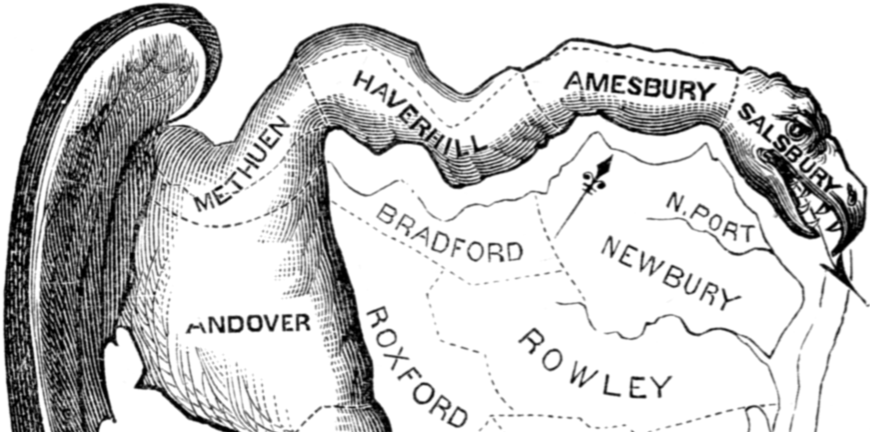
The Supreme Court has largely upheld the redistricting map drawn by the State of Texas, overturning the decision of a three-judge panel of the U.S. District Court that had held that a trio of districts in Texas had been drawn in a way that was racially discriminatory:
The Supreme Court on Monday largely upheld Texas congressional and legislative maps that a lower court said discriminated against black and Hispanic voters.
The lower court was wrong in how it considered the challenges, Justice Samuel A. Alito Jr. wrote in the 5 to 4 decision. The majority sided with the challengers over one legislative district.
Justice Sonia Sotomayor wrote a dissent that was longer than Alito’s majority decision. She said the decision “does great damage to the right of equal opportunity. Not because it denies the existence of that right, but because it refuses its enforcement.”
Alito was joined in the outcome by the court’s most consistent conservatives — Chief Justice John G. Roberts Jr. and Justices Anthony M. Kennedy, Clarence Thomas and Neil M. Gorsuch.
Thomas and Gorsuch added they do not believe the Voting Rights Act applies to redistricting.
Sotomayor was joined by the court’s liberals: Ruth Bader Ginsburg, Stephen G. Breyer and Elena Kagan.
(…)
After the 2010 census, Texas was awarded four new congressional districts because of the state’s population growth. Almost all of the growth came from an increase in black and Hispanic residents, but the new maps produced by the legislature fulfilled its goal of protecting Anglo Republicans, the challengers charged.
The maps were found by the district court to probably be unconstitutional, and the judges drew interim maps to be used in the 2012 elections.
The outcomes, though, were much the same. In 2013, the Republican legislature voted to permanently adopt those judicially drawn maps.
Texas argued it could not be a racial gerrymander when using the lines drawn by the neutral judges.
More from The New York Times
WASHINGTON — The Supreme Court on Monday largely upheld an array of congressional and state legislative districts in Texas, reversing trial court rulings that said the districts violated the Constitution and the Voting Rights Act by discriminating against voters on the basis of race.
The vote was 5 to 4, with the court’s more conservative members in the majority. Justice Samuel A. Alito Jr., writing for the majority, said the trial court had “committed a fundamental legal error” by requiring state officials to justify their use of voting maps that had been largely drawn by the trial court itself.
In dissent, Justice Sonia Sotomayor wrote that the majority opinion represented a dark day for voting rights.
The Constitution and the Voting Rights Act “secure for all voters in our country, regardless of race, the right to equal participation in our political processes,” she wrote. “Those guarantees mean little, however, if courts do not remain vigilant in curbing states’ efforts to undermine the ability of minority voters to meaningfully exercise that right.”
(…)
There was an odd wrinkle in the case: The San Antonio court itself had for the most part endorsed the contested maps in 2012, after the Supreme Court rejected earlier ones and told the court to try again. The 2012 maps, the panel later said, had been considered in haste in advance of pending elections. In 2013, the Texas Legislature decided not to draw new maps and instead mostly adopted the one drawn by the San Antonio court.
After three election cycles using the interim maps, the court ruled that they were flawed. “Although this court had ‘approved’ the maps for use as interim maps, given the severe time constraints it was operating under at the time of their adoption,” the court said, that approval was “not based on a full examination of the record or the governing law” and was “subject to revision.”
The court concluded that Texas’ adoption of the interim maps was part of “a litigation strategy designed to insulate the 2011 or 2013 plans from further challenge, regardless of their legal infirmities.”
Justice Alito disagreed. “There is nothing to suggest that the Legislature proceeded in bad faith — or even that it acted unreasonably — in pursuing this strategy,” he wrote.
Much of the dispute between the two sides in Monday’s decision concerned whether the case was properly before the justices at all.
The San Antonio court had not issued an injunction compelling the state to do anything, Justice Sotomayor wrote. Instead, it instructed Texas officials to promptly advise it about whether they would try to draw new maps. That meant, she said, that there was no lower-court decision for the Supreme Court to review.
But Justice Alito wrote that the trial court’s action was effectively an injunction and that the Supreme Court therefore had jurisdiction to hear the state’s appeal.
“The short time given the Legislature to respond is strong evidence that the three-judge court did not intend to allow the elections to go ahead under the plans it had just condemned,” he wrote. “The Legislature was not in session, so in order to take up the task of redistricting, the governor would have been required to convene a special session — which is no small matter.”
Amy Howe summarizes the opinion:
Justice Samuel Alito wrote for the majority, in an opinion joined by Chief Justice John Roberts and Justices Anthony Kennedy, Clarence Thomas and Neil Gorsuch. Alito began by rejecting the challengers’ contention that the Supreme Court lacked the authority to review the case at all because federal law only gives the court the power to hear appeals from a three-judge district court that either grants or denies an injunction – which, the challengers argued, the district court’s orders were not. Even if the district court had not specifically labeled the orders at issue in this case as “injunctions,” Alito explained, the real question is whether the orders had the “practical effect” of an injunction. And these did, he reasoned, because the orders not only found violations of federal law and the U.S. Constitution but also required the state to quickly notify the court whether the state legislature would meet to fix the violations. “The short time given the Legislature to respond,” Alito posited, “is strong evidence that the three-judge court did not intend to allow the elections to go ahead under the plans it had just condemned” – which, “for all intents and purposes, constituted” injunctions against the state.
Alito then turned to what he characterized as the main question on the merits of the state’s appeal: whether the district court was wrong “when it required the State to show that the 2013 Legislature somehow purged the ‘taint’ that the court attributed to the defunct and never-used plans enacted by a prior legislature in 2011.” According to Alito, the district court’s analysis was exactly backward: Even if a state has been found to have discriminated in the past, he observed, there is still a presumption that it acted properly in drafting later redistricting plans. This means that the plaintiffs challenging a redistricting plan still have to show that the legislature intended to discriminate when it enacted the current plan.
Alito acknowledged that the intent of the Texas legislature when it enacted the 2011 plan was something that a court could consider, and he added that the mere fact that the 2013 plans largely mirrored the 2012 interim plans adopted by the court did not immunize the 2013 plans from a challenge. But when all of the evidence is considered together, Alito concluded, it does not show that the legislature intended to discriminate against minority voters. If anything, Alito stressed, the available evidence suggests that the legislature did not intend to discriminate, but instead adopted the 2013 plans because it had been advised that doing so was the best way to end the “expensive and time consuming” litigation over the redistricting plans.
In response to the majority’s opinion, Justice Sonia Sotomayor wrote a dissent that was joined by the Court’s three other Democratic-appointed Justices that argued, interestingly enough, that the Court should not have reached the merits of the case. As Sotomayor notes in her dissent, this was because the three-judge panel did not grant or deny an injunction and warned that the majority’s decision to rule on the merits of the case would lead to a flood of litigants in similar cases requesting Supreme Court review in cases that are not appropriate for Supreme Court review. Despite that position, Sotomayor did not hold back her criticism of the Court’s ruling or Justice Alito’s reasoning in the majority opinion, as Howe goes on to note:
Although the majority should not have discussed the merits at all, Sotomayor continued, there too it went astray. First, Sotomayor complained, the district court did not (contrary to Texas’ assertion and the majority’s conclusion) get the legal test wrong: The district court did focus on the legislature’s intent when it adopted the 2013 plans, “rather than simply presuming invidious intent from the failure to remove the taint, as the majority claims.” And when all of the evidence is considered together, Sotomayor contended, the district court properly concluded that the legislature did intend to discriminate.
In a blistering final paragraph that closed with the phrase “I dissent,” rather than the “I respectfully dissent” often used by the justices, Sotomayor protested that today’s ruling “does great damage to” the right “to equal participation in our political processes.” “Not because it denies the existence of that right, but because it refuses its enforcement. The Court intervenes when no intervention is authorized and blinds itself to the overwhelming factual record below. It does all of this to allow Texas to use electoral maps that, in design and effect, burden the rights of minority voters.”
As noted, the Court did not completely absolve the State of Texas in this case. It held that one state legislative district was an improper racial gerrymander and that it must be redrawn pursuant to the Court’s ruling and the ruling of the three-Judge panel. That will likely require the redrawing of lines for several adjoining state legislative districts, but it will have at best a limited impact on the makeup of the Texas Legislature and no impact at all on the Congressional District map, which will remain in effect until redistricting takes place in the wake of the 2020 Census. Overall, then, the political impact of all of this is likely to be minimal at best, and it’s likely to mean that Texas will follow largely the same strategy in drawing the district lines after the 2020 Census that it did after the 2013 Census, with largely similar results.
This case, of course, follows on the heels of the Court’s ruling in the two political gerrymandering cases out of Wisconsin and Maryland, which it essentially punted back to the lower courts on procedural grounds. Unlike those cases, though, this case was a ruling on the merits, and one that largely rejected the formula that the lower Court used to find that there was improper considering to race given when the Court drew the current Congressional map and that at least two of the state’s Districts, the 27th Congressional District and the 35th Congressional District, were improperly drawn on racial grounds. Unlike the political gerrymandering cases, this essentially means the end of the challenges to the post-2010 Census map in Texas except with respect to that single state legislature district, although it’s likely to be some time before that issue is fully resolved.
Here’s the opinion:
Abbot Et Al v. Perez Et Al Opinion by Doug Mataconis on Scribd

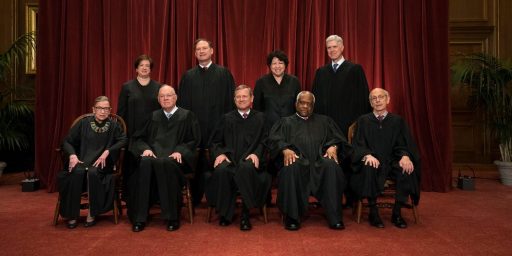
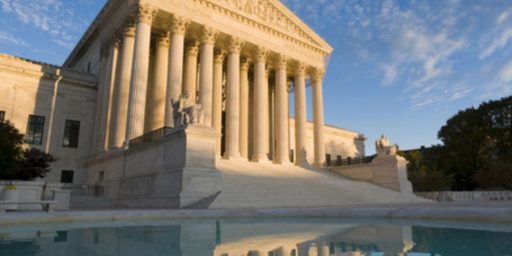
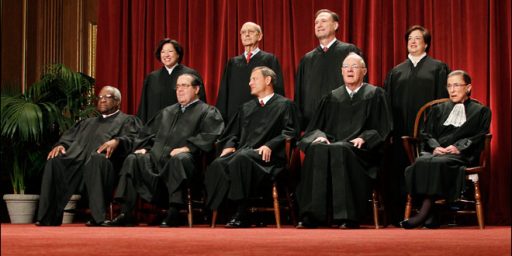
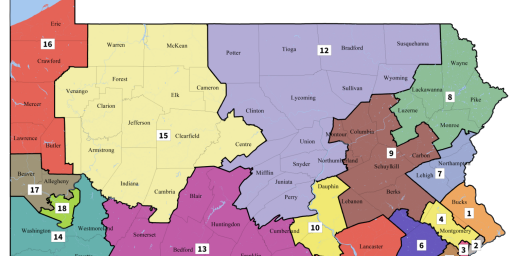
Maybe it’s inevitable as we get further down the road on these cases but this ruling is just inscrutable. It would seem not to apply to any subsequent situation. Much like the recent punt on the gay baker case, they ruled narrowly on the merits of a particular defendant, rather than making a ruling of broader applicability. Given SCOTUS’ diminished workload, that strikes me as a poor use of their time.
@James Joyner:
In the redistricting cases, the cases are usually very much sui generis because every case brings different facts, different maps, and different considerations. Even if the Court had reached the merits in the political gerrymandering cases, it likely would have resulted in more litigation as the courts attempted to apply the Supreme Court’s ruling to the case before them.
As far as the baker’s case goes, the facts in that case were indeed unique but as several commentators have noted they provide a roadmap for future cases that seems to suggest that in future cases regarding anti-discrimination claims and religious liberty claims it will be much harder for the party claiming the exception to the law to prevail unless they can show that the court below was somehow biased against them. In the Washington case that the court declined to hear today, the remand will give the florist a new argument to raise but it’s likely not going to be as successful as the Colorado case was.
@Doug Mataconis: Fair enough, although the 1990s cases on majority-minority districts actually yielded some useful opinions, providing a roadmap for legislatures attempting to both serve legitimate diversity interests while staying within the limits of contiguity, adherence to historical boundaries, etc. I don’t see much out of these last two, aside from deference to lines drawn for partisan reasons.
To me, the Supreme Court members seem to be scared of putting a firm stake in the ground. Perhaps because, as you’ve pointed out just recently, as everything in this country becomes more and more political, they don’t want to be seen as “taking sides.” So they issue narrow rulings that don’t actually do much more than kick the can down the road, while praying that some of these flash lines get resolved politically, not legally. If you look back at it, the Court didn’t make a definitive ruling on gay marriage until after it was legal in the majority of states via other means. They don’t want to lead.
Speaking as a cranky old man it calls to mind one of my favorite rants about how we’ve replaced the idea of judgement, with all the grey areas and occasional faulty decisions it implies, with the idea of black and white laws and outcomes. Whether you’re talking mandatory sentencing guidelines, or Robert’s lamenting about what defined standard they could apply to determine if a district is overly gerrymandered, the lack of faith in simple human judgement is crippling. Can you imagine a judge today saying he might not be able to define porn, but he recognizes it when he sees it? I bet anything that most of the Supreme Court in this case recognized these as gerrymandered districts, but because they couldn’t find a non-controversial standard that wouldn’t tick off one side or the other, they just punted.
A far cry from the Warren court, for sure. And you could even make an argument (certainly many conservatives do) that a less active court is beneficial (though I wouldn’t take that argument NEARLY as far as today’s reactionary so-called “conservatives” do). The problem (or rather, another problem) today, as I see it, is that we already have one branch of government basically refusing to do it’s job and exercise leadership (almost by definition, leadership requires judgment). Far easier to blame everyone else and do nothing. If another branch continues to be scared of exercising leadership or judgment, it just continues the spiral into authoritarianism that we seem to have entered, as it pushes more and more actual decisions to the executive while hiding behind legal minutiae.
Also, get off my lawn!
What would it take, I wonder, for members of Congress and of the Supreme Court to do their damn jobs rather than running scared and allowing a two-bit tin-pot dictator wannabe to continue to go around damaging America’s credibility, both at home and abroad, becoming a major embarrassment and putting a nasty, filthy stain on our country…
As a Brit I must say our independent non-partisan Constituency Boundaries Commission is a shining example of what the US desperately needs.
Personally I am a total supporter of PR but as a make the best of the appalling current system goes it works really well.
I look askance at the US electoral and judicial systems which seem to me designed for prejudice and failure.
OT: Trump’s going berserk on Harley Davidson:
FYI Harleys have also been made in Brazil for 20 years, and Harley parts have been made all over the world since 1928.
@teve tory:
Ah, come on, man. How could Trump be expected to know that?
@Just Another Ex-Republican:
I suspect part of that is due to the increasing political polarization. When you have a dispute between two sides with a vastly different (and at times downright contradictory) sense of what is fair, then hard and fast rules are often the only real mechanism available. Sports tend to mainly have black and white rules for that reason (ie why a foul was committed is usually irrelevant), and anyone who’s been a parent will know how often you have to toe the line on a black and white rule simply to avoid appearing to favor one child over another.
Rules that are black and white will leave people grumbling about the rules; rules that are open to interpretation will leave people grumbling about the people making the judgments. The court might well feel that chaos will result from subtle judgment at this point.
@george: If avoiding chaos and people grumbling is the goal, I think the last couple days (gerrymandering, travel ban, California clinics) is pretty good evidence that they are doing a crappy job of it.
Sorry in advance–long rant ahead.
In the end, even black and white rules almost never actually are that simple. The NFL can’t figure out what a catch is (or when to call holding), baseball’s strike zone is a mystery, whether you get called for traveling in basketball seems to depend on how big a star you are, hockey can never figure out what obstruction is, and the Supreme Court tied itself into knots today to convince itself that Trump’s travel ban wasn’t aimed at Muslims. The problem with so called thinkers like Gorsuch and the rest of the conservative wing is they hide behind the fiction that strict textual readings reveal some definitive result. It doesn’t–there is ALWAYS judgment involved, they just want to pretend they are perfectly objective (when no human is). And so the right pretends that only liberals are activist judges interpreting things, while GOOD judges are merely looking at the text. It’s bull*&^&U. To go back to your sports concept, referees and umps still have to make a call and sure, we grumble and rant about them constantly. But no one pretends that judgment isn’t involved. We seem to reserve that for legal arguments, where somehow Roberts can write dozens of pages of legal minutiae and use the fallacy of strict textualism to conclude Trump has the authority to ban travel from certain countries *even while explicitly saying the Court takes no position on the “soundness” of the policy* (that’s not a very subtle comment on what he thinks of it), and Kennedy all but admitted he thought the policy was ridiculous but there was no legal rationale for overturning it.
As for me, I may not be able to give you a legal textbook definition of racism and religious intolerance that covers every possible situation, but I know it when I see it. And this Supreme Court (with the exception of Sotomayor & Ginsburg) is too cowardly to call it out.
We all want to believe “it could never happen here.” But it is, right in front of our eyes. Both Constitutionally defined checks (Congress, Supreme Court) on the executive have waved the white flag. The implicit check of a free press is under daily assault (how long until the suggestion comes out that we should round up “enemies of the people”, if it hasn’t already?), with the single largest media outlet in the country little more than the propaganda arm of the Trump executive. The final check of free elections is being undermined by rampant gerrymandering, voter suppression, and the previously mentioned propaganda being spewed out so people aren’t even aware of actual facts any more.
This blog has posted a lot about the “norms” being violated routinely these days. Kennedy and Roberts (I have no hope at all for Alito, Gorsuch, or Thomas, but those two have sometimes showed glimpses of understanding) chickened out on these recent rulings because they want to pretend we still have a “normal” executive and legislative branch. We don’t. They are failing, utterly failing, to be a check on the Executive branch. Instead they are just praying that someone else steps up to deal with the fact that political gerrymandering is very real, the travel ban is not sound or just policy, and ICE is out of control. At a time when the Court needs giants, we have midgets.
We are dangerously close to Niemoller’s famous poem actually becoming relevant in this country. Not there yet-we’re only rounding up one group of people (people *accused* of being illegal immigrants, though Trump wants to deny them a hearing that would actually prove that) and believe it or not I don’t want to overstate how serious things are. But we are apparently just fine with trying to exclude “the other” from coming in, and it’s almost inevitable that excluding will next lead to attempts to get rid of the ones who are already here. Subsititute immigrants for Socialists, Muslims for Trade Unionists, and the press? liberals? for Jews, and where do you end up?
———————————————————————————-
First they came for the Socialists, and I did not speak out—
Because I was not a Socialist.
Then they came for the Trade Unionists, and I did not speak out—
Because I was not a Trade Unionist.
Then they came for the Jews, and I did not speak out—
Because I was not a Jew.
Then they came for me—and there was no one left to speak for me.
—————————————————————————–
I wish I was in position to follow Reynolds and Harvard92 out of the country, because we ARE on that slippery slope to authoritarianism, and our institutions have already been damaged (sorry Doug, our institutions aren’t going to be damaged “at some point”, they already have been). It’s not an irreversible slide yet but the slope got noticeably steeper the last couple days.
Sorry for going on so long.